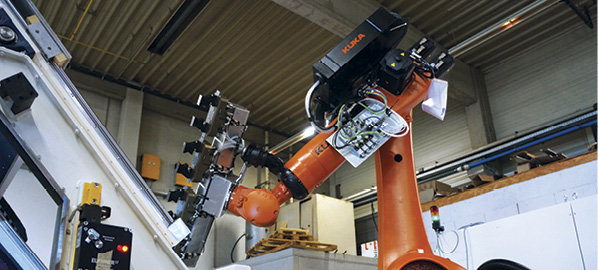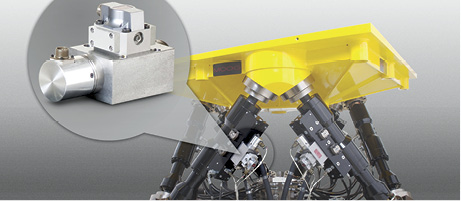Changing a Vacuum Cup
Vacuum cups are used throughout industry for so many applications that the list would take up most of this page. Fundamentally, vacuum cups are used to grip a product while it is lifted, clamped, or conveyed from one place to another. There are many different designs and styles available from numerous manufacturers in various materials and compounds. This article explains what basic criteria should be understood to successfully change a vacuum cup for an alternative model.
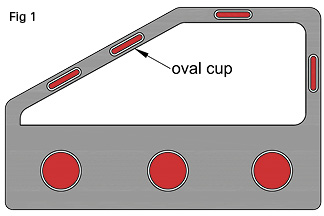 One of the biggest mistakes made by a salesman in selecting a vacuum cup for a customer is trying to find or apply an exact replica of the one that is already in use. Just because the cup is working does not mean you can’t offer a better alternative based on type, size, or even cup material. Basically there are three types of vacuum cups: flat, bellows, and multiple bellows, which are usually round in shape. Of course there is sometimes the need to use specific shapes determined by the item being picked up. Fig. 1 shows a doorframe blank where oval cups are used to grip the window frame. This oval cup choice maximizes surface area compared to numerous round cups. However on the larger surface, round cups are an easier choice, and round cups are by far the most popular in use today.
One of the biggest mistakes made by a salesman in selecting a vacuum cup for a customer is trying to find or apply an exact replica of the one that is already in use. Just because the cup is working does not mean you can’t offer a better alternative based on type, size, or even cup material. Basically there are three types of vacuum cups: flat, bellows, and multiple bellows, which are usually round in shape. Of course there is sometimes the need to use specific shapes determined by the item being picked up. Fig. 1 shows a doorframe blank where oval cups are used to grip the window frame. This oval cup choice maximizes surface area compared to numerous round cups. However on the larger surface, round cups are an easier choice, and round cups are by far the most popular in use today.
The dimensions and features of the internal neck (illustrated in Fig. 3) of the vacuum cup is the most important dimensional information to be aware of when offering an alternative cup. If the new cup fits the existing fitting, then all is well. If it does not, however, the next most important feature is the fitting thread. Fitting threads are normally standard, being male or female NPT or BSPP. If the alternative manufacturer can offer a similar cup with a fitting thread that is the same as the competitors, then the complete assembly can be changed out.

Fig. 2 shows a typical bellows cup. The images show the cup by itself, its intended fitting, and the complete assembly. This fitting is suitable for a variety of different cups, but if the salesman is representing a different manufacturer, the chances are that the fitting will not be suitable for the new cup brand.
Of course there are cost limitations to this, as you would have to supply new fittings, whereas the competitor, of course, only needs to supply a rubber cup. Consideration of the project should be made in this situation. If the customer is going through nearly 1,000 cups a year, for example, it’s an attractive opportunity to sell your brand of vacuum cups. If there are 80 cups in place (each cup being replaced 12 times per year or every month), then you will need to supply and probably cover the cost of 80 fittings. The cost of the fittings versus the profit on 1,000 cups will determine if this is viable.
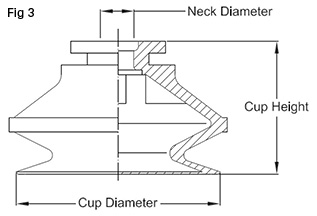 Overall cup height (Fig. 3) is also an important dimension. The machine is probably set up accurately based on the approach distance to the product being lifted. If the new cup choice is 1/2-in. (12-mm) longer, can the machine operator change the approach distance, or indeed do they want to be bothered with a machine setup change? If the financial savings are there, more likely the user will make the one-time machine set up.
Overall cup height (Fig. 3) is also an important dimension. The machine is probably set up accurately based on the approach distance to the product being lifted. If the new cup choice is 1/2-in. (12-mm) longer, can the machine operator change the approach distance, or indeed do they want to be bothered with a machine setup change? If the financial savings are there, more likely the user will make the one-time machine set up.
This exercise is purely commercial and certainly commonplace in vacuum cup sales activity. However, a lot of applications may warrant different vacuum cups purely because the ones currently in use are not the most suitable for the application. When handling cardboard boxes, a very common vacuum cup application, different machine builders select different materials. This is normally based upon an historical purchasing habit or simply availability from their chosen supplier. However, just because the user has been using a particular vacuum cup for many years does not mean an improvement cannot be made. When handling cardboard boxes, for example, consideration should be made to the cup material. Silicone vacuum cups are a good choice due to the low Durometer (hardness), which allows them to seal very well against the uneven cardboard surface. This allows a higher vacuum level, and therefore a smaller vacuum pump or generator can be used, as leakage between the cup and product is much less. That said, silicone has a lower wear resistance than a Nitrile-based compound, so the cup replacement will be more frequent.
Some cups are made from a PVC compound, which is a plastic-based material. Although they are hard wearing, they work harder instead, which means life is shortened, particularly in a compressing cup such as bellows model. Because of this, this type of material has a low initial cost for the machine builder, but user ownership could be a lot higher than a rubber compound model due to frequent cup changes.
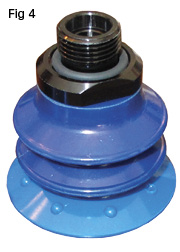 Cup diameter is often the first cup feature to be referenced when selecting a cup from a manufacturer’s catalogue. However, the cup diameter is rarely critical in most applications. Cup diameter and vacuum level determine the lifting capacity of the vacuum-lifting system. A small vacuum cup has a tremendous holding force, which very rarely relates to the weight of the product being handled. For example, a 2-in. (50-mm) diameter vacuum cup has a theoretical holding force in excess of 25 lbs at 20″Hg. If this was used to hold a 20-lb box, the theory works. Of course the problem would be that the box deforms when picked up in the center by a single cup. Therefore, numerous cups offering support across the top of the box will be a successful system. If six Ø50mm cups were used, the holding force at 20″Hg would be in excess of 150 lbs. The point is that the cup diameter is rarely the defining feature of a successful lifting system. If the sales person offered 40-mm diameter cups to replace the existing 50-mm cups, the holding force would still be in excess of 100 lbs, and the customer would probably save money in the process.
Cup diameter is often the first cup feature to be referenced when selecting a cup from a manufacturer’s catalogue. However, the cup diameter is rarely critical in most applications. Cup diameter and vacuum level determine the lifting capacity of the vacuum-lifting system. A small vacuum cup has a tremendous holding force, which very rarely relates to the weight of the product being handled. For example, a 2-in. (50-mm) diameter vacuum cup has a theoretical holding force in excess of 25 lbs at 20″Hg. If this was used to hold a 20-lb box, the theory works. Of course the problem would be that the box deforms when picked up in the center by a single cup. Therefore, numerous cups offering support across the top of the box will be a successful system. If six Ø50mm cups were used, the holding force at 20″Hg would be in excess of 150 lbs. The point is that the cup diameter is rarely the defining feature of a successful lifting system. If the sales person offered 40-mm diameter cups to replace the existing 50-mm cups, the holding force would still be in excess of 100 lbs, and the customer would probably save money in the process.
The style of vacuum cup is also not that important, in respect to being exactly the same. A 1½ bellows cup as shown in Fig. 3 can most likely replace a 2½ bellows as shown in Fig. 4, unless the application has definitely determined that a longer bellows is more suitable such as it requires a longer independent cup “lift” when vacuum is applied. Understanding the application is very important when changing the cup style. If a test is required, then this should be done, of course. A sales person that has different cup samples with them when looking at a cup application is certainly ahead of the game.
The most important part of a vacuum cup when offering a different model, as explained at the beginning of this article, is the neck diameter or mounting feature. Will the cup fit on the cup fitting? If not, can you use a different size cup that will fit, or can you, based on initial cost, offer a new fitting suitable for your cup choice? Is the customer using the correct material for the application? Is the cup wearing quickly or splitting where it connects to the fitting? Is the cup applied correctly or was it a choice made purely on initial cost? More often than not, a selection of less than 20 cups in your complete portfolio is more than enough for most applications. The reason for there being so many cups in existence is the same as most simple technologies: independent, international, creative R&D departments and the ever-present re-invention of the wheel.
This article is intended as a general guide and as with any industrial application involving machinery choice, independent professional advice should be sought to ensure correct selection and installation.




